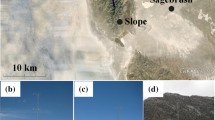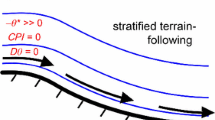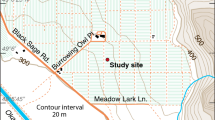Abstract
A two-dimensional, time-dependent flow model coupled with a radiative transfer module has been applied to examine the characteristics of nocturnal flow in a steep canyon in the Rocky Mountains in Colorado. The effect of nighttime surface cooling on drainage flow is examined and compared with observations. In a complementary study, tracer data have been analyzed to estimate the mass flux from a tributary canyon and to examine processes of transport and diffusion. Simulations indicate that the strength and structure of the drainage wind are controlled mainly by terrain features, ambient wind conditions, and effective radiative cooling rates. The transport of tracer from a lower secondary vortex to an upper primary vortex is largely controlled by diffusional processes; removal of tracer from the canyon is controlled by the primary vortex and its interaction with the ambient wind. Differences between mass fluxes from model simulations and those calculated from experiments involve uncertainties in both the structure of the model and the analysis of data.
Similar content being viewed by others
References
Arakawa, A.: 1972, ‘Design of the UCLA General Circulation Model’, Technical Report No. 7, Department of Meteorology, University of California, Los Angeles.
Chou, M.-D.: 1984, ‘Broadband Water Vapor Transmission Functions for Atmospheric IR Flux Computation’,J. Atmos. Sci. 41, 1755–1778.
Chou, M.-D. and Peng, L.: 1983, ‘A Parameterization of the Absorption in 15 mm CO2 Spectral Region with Application to Climate Sensitivity Studies’,J. Atmos. Sci. 40, 2183–2192.
Clements, W. E., Archuleta, J. A., and Gudikson, P. H.: 1989, ‘Experimental Design of the 1984 ASCOT Field Study’,J. Appl. Meteorol. 28, 405–413.
Coulter, R. L., Orgill, M. and Porch, W.: 1989, ‘Tributary Fluxes into Brush Creek Valley’,J. Appl. Meteorol. 28, 555–568.
Deardorff, J. W.: 1973, ‘The Use of Subgrid Transport Equations in a Three-Dimensional Model of Atmospheric Turbulence’,J. Fluid Eng. 95, 429–438.
Fouquart, Y.: 1988, ‘Radiative Transfer in Climate Modeling’, in M. E. Schlesinger (ed.),Physically-Based Modelling and Simulations of Climate and Climate Change, NATO Advanced Study Institute Series, pp. 223–283, Kluwer, Dordrecht, the Netherlands.
King, M. D. and Harshvardhan: 1986, ‘Comparative Accuracy of Selected Multiple Scattering Approximations’,J. Atmos. Sci. 43, 784–801.
Kneizys, F. X., Shettle, E. P., Gallery, W. O., Chetwynd, J. H., Jr., Abreu, L. W., Selby, J. E. A., Clough, S. A. and Fenn, R. W.: 1983, ‘Atmospheric Transmittance/Radiance: Computer code LOWTRAN 6’, Optical Physics Division, Hanscom AFB, Bedford, MA.
Lacis, A. A. and Hansen, J. E.: 1974, ‘A Parameterization for the Absorption of Solar Radiation in the Earth's Atmosphere’,J. Atmos. Sci. 31, 118–133.
Lee, I. Y. and Park, H. M.: 1994a, ‘Comparison of Microphysics Parameterizations in a Three-Dimensional Dynamic Cloud Model’,Atmos. Environ. in press.
Lee, I. Y. and Park, H. M.: 1994b, ‘Parameterization of Pollutant Transport and Dispersion in Urban Street Canyons’,Atmos. Environ. in press.
Oh, J.-H.: 1989, ‘Physically-Based General Circulation Model Parameterization of Clouds and Their Radiative Interaction’, Ph.D. Dissertation, Oregon State University, Corvallis, Oregon.
Patankar, S. V.: 1980,Numerical Heat Transfer and Fluid Flow, McGraw-Hill, New York.
Sommeria, G.: 1976, ‘Three-Dimensional Simulation of Turbulent Processes in an Undisturbed Trade Wind Boundary Layer’,J. Atmos. Sci. 33, 216–241.
Wiscombe, W. J. and Evans, J. W.: 1977, ‘Exponential-Sum Fitting of Radiative Transmission Functions’,J. Comp. Phys. 24, 416–444.
Author information
Authors and Affiliations
Rights and permissions
About this article
Cite this article
Lee, I.Y., Coulter, R.L., Park, H.M. et al. Numerical simulation of nocturnal drainage flow properties in a rugged canyon. Boundary-Layer Meteorol 72, 305–321 (1995). https://doi.org/10.1007/BF00836338
Revised:
Issue Date:
DOI: https://doi.org/10.1007/BF00836338




